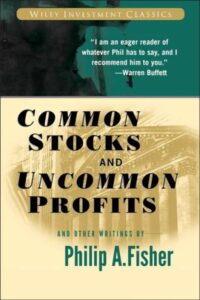We’ll explore the three key points from the must-read classic, “Common Stocks and Uncommon Profits,” published in 1956. Make sure you read till the end because I’ll share a brilliant bonus insight from the book that you must not miss.
Despite being released in 1956, Philip Fisher’s book contains timeless investment principles that have remained incredibly valuable.
Key idea 1: Have a long-term mindset
The book recommends looking for long-term potential instead of getting caught up in the excitement of trading stocks frequently for quick profits. The companies we want to search for are likely not glamorous or hyped by the media as those stocks will likely be overpriced. Finding stocks with potential can often be challenging; however the rewards are worth it.
According to Philip Fisher, you want to search for companies continuously allocating money into research and development. A good example is Netflix, which transitioned from DVDs to video-on-demand streaming. A forward-thinking move allowed the company to continue expanding while its competitors like Blockbuster collapsed.
Companies with top potential also boast a strong management structure and foster positive relations. It’s crucial to stay away from investing in companies with internal conflicts and uninspiring leadership.
Key idea 2: The Scuttlebutt method
I thought we were learning about investing and not butts, says Newbie Nick. Yeah of course Nick, you see the Scuttlebutt method involves gathering information by speaking with suppliers, customers, and even former employees. These resources are crucial to unlocking valuable insights about a company’s operations and industry trends. You won’t find these insights in financial reports or in the media.
Here’s a funny story to help show the power of the Scuttlebutt method. Imagine you’re interested in investing in a business that makes shoes so you decide to follow Fisher’s advice and do some Scuttlebutt research.
Upon visiting the shoe factory, you talk with an employee who seems to know everyone in the company. You mention you’re considering investing in the stock, and to your surprise, he says:

There you go; you found valuable information you probably wouldn’t have seen from other sources. You will pass on the investment and avoid potential losses thanks to your Scuttlebutt research.
According to the book, the Scuttlebutt method can also be used to go deeper into customer relations and former employees’ views about a company. Be sure to understand biased opinions when using this method, especially when contacting a company’s competitors for insights.
Key idea 3: Use diversification and study market cycles
Prices rarely reflect a company’s true value because market perceptions influence them; hence, timing an entry into the market may be advantageous. People’s ideas are frequently incorrect so avoid being misled by popular opinion and herd mentality. Instead, Fisher says do the opposite of the majority and buy equities after a significant decrease in order to profit from greater growth.
Doubt is a barrier for investors, especially when attempting to do the opposite of the majority. It’s natural to doubt your talents, yet great investors are frequently extremely confident in their selections. If you believe in the potential of a firm, you should have faith and invest. After all, according to the book, buying while the majority are selling can eventually lead to large returns.
Fisher emphasizes the importance of being patient and holding a stock once you’ve identified the right opportunity. Giving investments time to flourish and reach their true potential is vital. He warns against trying to time the market or make quick gains.
According to the book, logical reasons to close an investment include misjudging the company’s growth potential or significant changes to the company. Other important factors include change of management, shifting industry outlook, or poor fundamentals.
Holding onto quality stocks with top potential can lead to significant compounded returns. Additionally, a longer-term perspective helps investors deal with temporary stock price volatility until the market behaves more rationally.
The book also recommends spreading your investments across various industries and sectors. Diversification helps reduce the risk associated with individual stocks or a potential industry downturn. Even the most brilliant companies can have surprising challenges, so it’s important to diversify.
At the start, I mentioned that later on you’ll get a valuable bonus insight. For the bonus, we’ll go through the top 10 points from Philip Fisher’s 15-point checklist, as it helps as a guide for identifying great investment opportunities.
- Low share dilution risk

Share dilution is when new shares are issued, causing the existing shareholders’ percentage in ownership to fall. Businesses with strong cash flow and a large amount of cash in the bank stand a better chance of borrowing if times get challenging. An extra opportunity for borrowing and strong cash positions helps shareholders with a decreased risk of share dilution.
- Company culture matters
It is difficult to work out if a manager truly appreciates and values their team. However, we can examine employee feedback and talk to former employees to get a general idea if employees are happy. A company that treats its employees as valuable humans and not a cog in a wheel will prosper more.
- Research and development investment
A company not investing much into development is a major warning as it’s a key driver for growth. Companies that sensibly turn their research investments into revenue growth are the ones it makes sense to watch.
- Industry expertise
Search for companies with a competitive advantage and rise above in key aspects of their industry. Every industry has unique key performance metrics, so work hard to figure out what these are and if the business is outperforming them.
- Long-term profit perspective
Look for businesses which invest in stakeholder relationships that provide the groundwork for long-term success. Companies with a long-term goal for sustainable growth face less risk than organizations seeking a large return quickly.
- Management integrity

It’s key to find management that are transparent about their motivations and honest about the company’s outlook. Be careful of companies that overly highlight good news and hide bad news. Strong management structure is also crucial, as organizational growth is vital to large-scale development.
- Efficient cost analysis
A company that has efficient cost structures and allocates resources effectively is a great sign. Invest in mature companies with high margins on their operational income and increased customer retention to help your prospects.
- Look into expanding markets
Look at companies driving growth in industries that are growing fast, such as clean energy, AI, or machine learning. However, be aware that the media can overhype these companies, and you must thoroughly research just how you’d do with any other company.
- Value Innovation Highly
Remaining stagnant in a rapidly developing world (insert: globe with development) is not good for long-term growth. Look for management that values innovation and the ability to develop new products.
- Sustainable Margins
Seek businesses with impressive profit margins as this gives shareholders a margin of safety during challenging times.
The book provides timeless investment principles as relevant at present as when the book was initially published. Following and adapting these principles to current market conditions can boost the chances of achieving long lasting investment success. If you enjoyed reading this make sure you check out more content from the blog.



